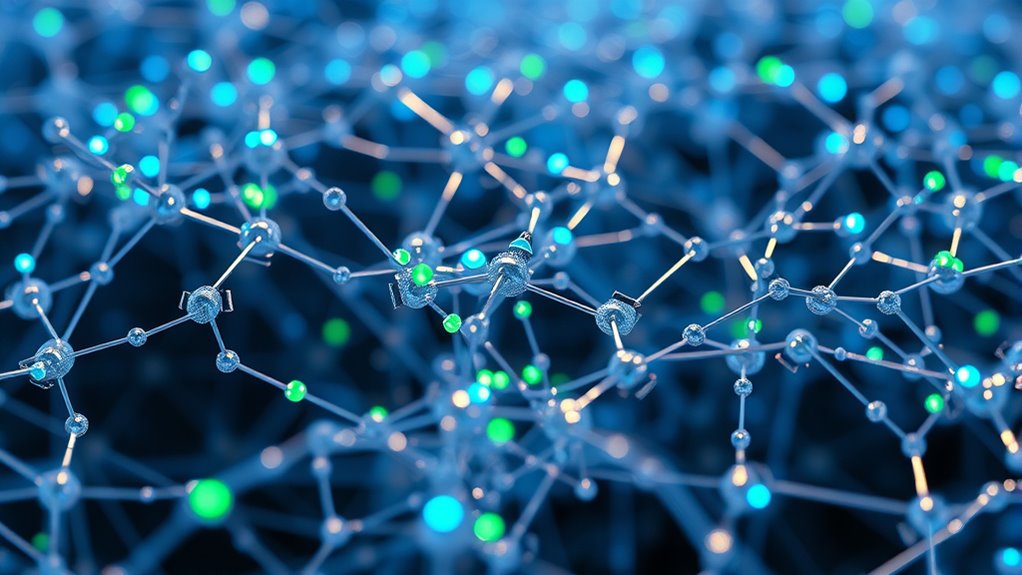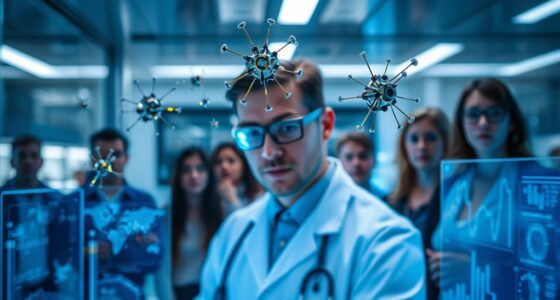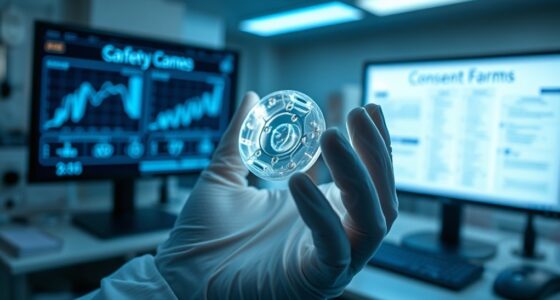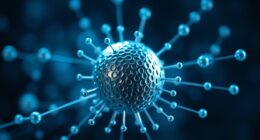Nanomachines combined with artificial intelligence are revolutionizing your world by enabling tiny devices to operate autonomously and precisely at the molecular level. These smart systems use advanced materials and AI algorithms to detect, decide, and respond in real time, transforming fields like healthcare, manufacturing, and environmental monitoring. They are designed to be efficient, adaptable, and safe, paving the way for smarter, safer, and more personalized solutions. Continuing further will reveal how these innovations are shaping the future.
Key Takeaways
- Nanomachines leverage quantum effects and surface forces for precise molecular control and autonomous self-assembly.
- AI algorithms optimized for size and energy enable real-time environmental sensing and decision-making at the nanoscale.
- Integration of nanomaterials like graphene and quantum dots enhances device performance, flexibility, and sensing capabilities.
- Challenges include energy management, movement accuracy, and safety, addressed through advanced materials and control strategies.
- These smart nanosystems are transforming healthcare, manufacturing, and environmental monitoring with autonomous, adaptive functions.
The Foundations of Nanoscale Machinery

To build effective nanoscale machinery, understanding the fundamental principles that govern their design and operation is essential. At this tiny scale, classical physics gives way to quantum effects, which influence how molecules move and interact. You need to grasp how surface forces, such as Van der Waals interactions and electrostatics, dominate over bulk properties. Precise control of molecular structures and bonds allows you to engineer components with specific functions. Self-assembly becomes a key technique, enabling molecules to organize into desired configurations without external guidance. Materials like carbon nanotubes, DNA, and proteins serve as building blocks, offering strength, flexibility, and programmability. Mastering these foundational concepts guarantees you can design nanoscale machines that perform reliably and efficiently within complex environments. Understanding these materials, including recycled products, can also contribute to sustainable nanoscale engineering solutions.
Integrating Artificial Intelligence Into Tiny Devices
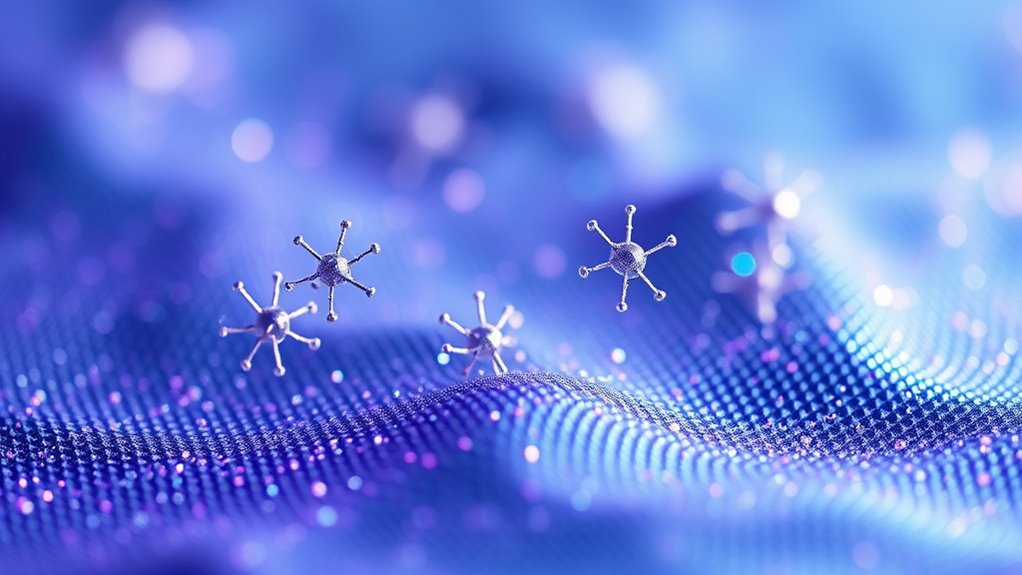
You can embed miniature AI algorithms into nanodevices to enable smarter functions. These tiny systems can autonomously control their actions and adapt to changing environments. By processing data in real time, they improve efficiency and open new possibilities for nanoscale applications. Additionally, integrating high-precision control mechanisms can further enhance their performance and reliability.
Miniature AI Algorithms
How do tiny devices perform complex tasks with limited space and power? They rely on miniature AI algorithms optimized for size and efficiency. These algorithms are streamlined versions of their larger counterparts, designed to run on tiny processors with minimal energy. Instead of heavy computations, they use simplified models and clever data handling to make quick decisions. Techniques like quantization reduce data precision, saving space, while edge computing allows processing directly on the device. Machine learning models are tailored to be lightweight yet effective, enabling nanomachines to detect signals, analyze environments, and respond swiftly. This optimization guarantees that even at a microscopic scale, AI can function reliably without draining power or exceeding size constraints, empowering tiny devices to perform sophisticated functions autonomously. Efficient processing ensures that these systems can operate seamlessly within strict limitations.
Autonomous Nanodevice Control
Integrating artificial intelligence into autonomous nanodevices enables them to make real-time decisions without external input. This advancement allows nanodevices to adapt and respond immediately to their environment. Here’s how AI-driven control enhances their capabilities:
- Environmental sensing: Nanodevices analyze chemical, biological, or physical signals instantly.
- Decision-making: They evaluate data, determining the best course of action.
- Adaptive responses: Actions are tailored based on current conditions, increasing efficiency.
- Self-regulation: Devices adjust their functions dynamically, maintaining ideal performance.
- Vetted products and standards ensure safe and effective operation of these tiny systems.
This seamless integration reduces reliance on external commands and streamlines operations at the nanoscale. It empowers nanomachines to perform complex tasks autonomously, making them invaluable in medicine, environmental monitoring, and beyond.
Real-Time Data Processing
Advancements in artificial intelligence enable tiny devices to process data in real time, allowing you to analyze information instantly as it’s collected. This capability enhances responsiveness, enabling nanomachines to make decisions on the fly. For example, in medical applications, nanodevices can detect anomalies and respond immediately. To understand the impact, consider the table below:
| Feature | Benefit |
|---|---|
| Instant Data Analysis | Faster decision-making |
| Local Processing | Reduced reliance on external systems |
| Energy Efficiency | Minimized power consumption |
| Adaptability | Devices learn and improve over time |
| Scalability | Multiple devices coordinate seamlessly |
This integration transforms nanomachines into smarter, more autonomous systems, capable of complex tasks at the nanoscale. Enhanced performance is achieved through these real-time processing capabilities, paving the way for more sophisticated applications.
Key Applications of Smart Nanosystems

Smart nanosystems are revolutionizing various fields by enabling precise control at the molecular level. You can harness their power in several key applications.
Smart nanosystems enable precise molecular control, transforming healthcare, environment, and manufacturing with innovative applications.
A new sentence with peer-reviewed studies and the rest of the sentence.
Challenges in Developing Intelligent Nanomachines
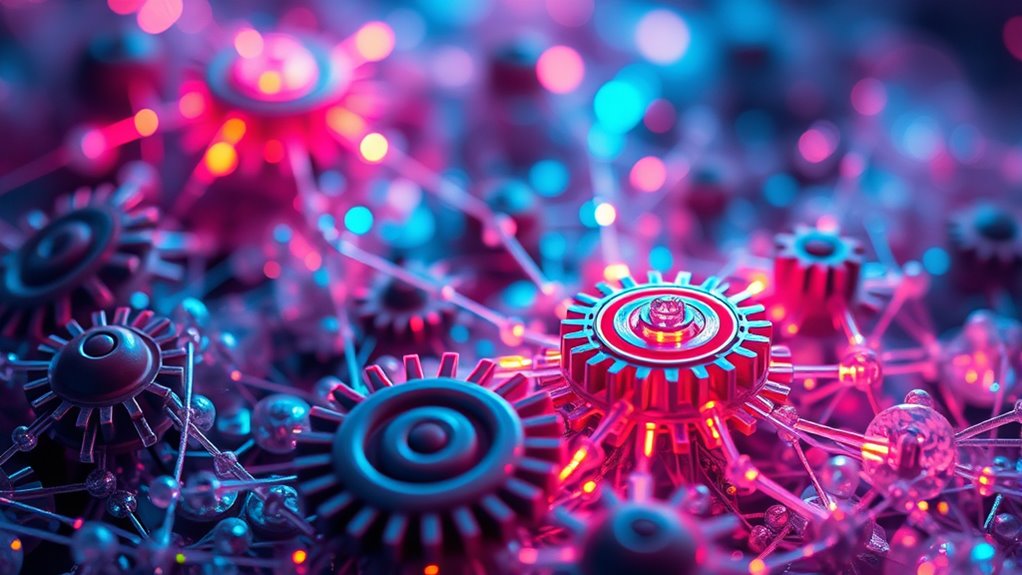
You’ll find that achieving precise control over nanomachines remains a major hurdle, as their tiny scale makes accurate manipulation difficult. Managing energy efficiently is also a challenge, since nanomachines need reliable power sources without bulky batteries. Overcoming these issues is essential to make intelligent nanomachines practical and effective. Additionally, developing advanced spray tips that can operate at such small scales could facilitate better control and functionality in nanomachines.
Precise Control Challenges
Developing intelligent nanomachines faces significant hurdles in achieving precise control at the microscopic scale. You need to manage movements with nanometer accuracy, which is inherently difficult due to several factors:
- Variability in environmental conditions, like temperature and humidity, can affect nanomachine behavior.
- Limitations of current sensing technologies make real-time feedback challenging.
- Manufacturing inconsistencies lead to unpredictable performance.
- Quantum effects at this scale can cause unpredictable behavior, complicating control strategies.
- Additionally, understanding the best anime movies and their storytelling techniques can inspire innovative approaches in nanomachine design.
Overcoming these issues requires innovative approaches in sensor design, control algorithms, and fabrication techniques. You must develop systems that adapt quickly to changing conditions and maintain accuracy despite physical and environmental uncertainties. Achieving reliable control at this scale remains one of the most complex challenges in nanotechnology.
Energy Management Difficulties
How do nanomachines sustain their energy needs at such a tiny scale? They face significant challenges because traditional power sources, like batteries, are too bulky and impractical. Instead, you rely on nanoscale energy harvesting methods, such as capturing energy from ambient sources like light, heat, or chemical reactions. However, these sources often provide limited, inconsistent power, making continuous operation difficult. Storage is another obstacle; miniaturized batteries or capacitors must be tiny yet efficient, which is tough to achieve. Managing energy without overheating or depleting resources quickly becomes a balancing act. These difficulties hinder the development of fully autonomous, intelligent nanomachines capable of complex tasks over extended periods, posing a major hurdle in advancing nanoscale smart systems. Additionally, the Efficiency of energy conversion at such a small scale remains a significant factor influencing their practical deployment.
Advances in Materials for Nanoscale AI Devices
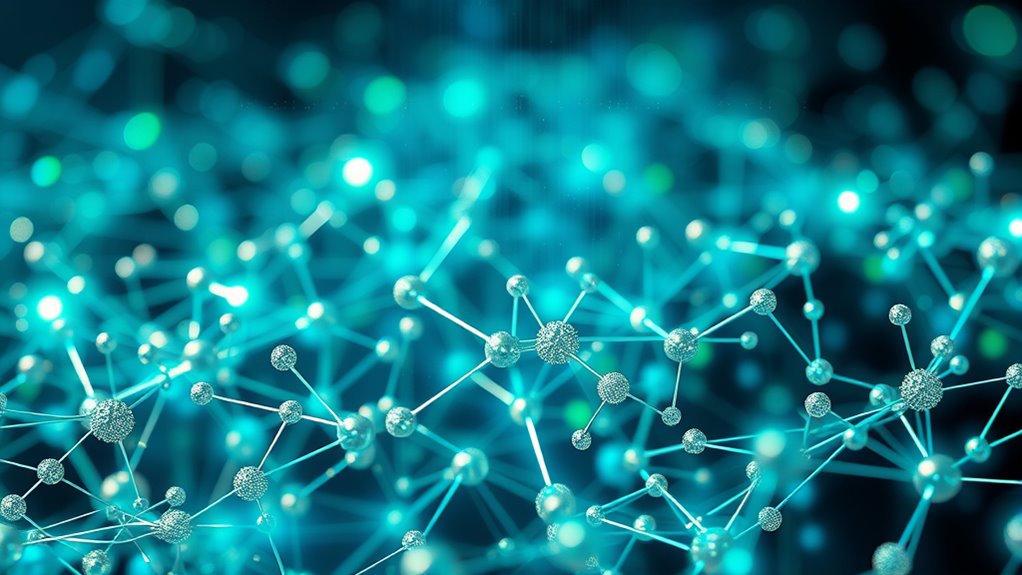
Advances in materials for nanoscale AI devices are transforming the possibilities of miniaturized technology. New materials enable faster processing, better energy efficiency, and enhanced durability at the nanoscale. Here’s what’s driving these innovations:
- Graphene and 2D materials – offering exceptional conductivity and strength, ideal for flexible nanosystems.
- Quantum dots – providing precise control over electronic properties for advanced sensing.
- Metal-organic frameworks (MOFs) – enabling selective molecular interactions for targeted functions.
- Nanostructured polymers – delivering lightweight, adaptable components with embedded intelligence.
– The development of trusted cryptocurrency storage solutions is crucial for protecting sensitive data in these advanced systems.
These materials push the boundaries of what nanoscale AI devices can achieve, opening avenues for smarter, more resilient systems. Your understanding of these innovations will be key to recognizing future breakthroughs in nanotechnology.
Ethical and Safety Considerations
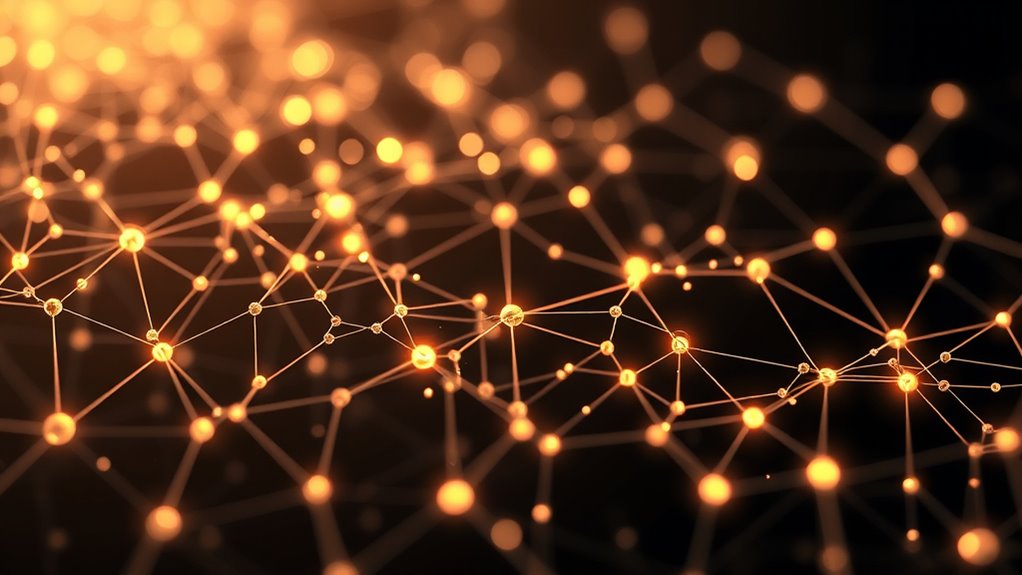
As nanoscale AI devices become more integrated into daily life, addressing their ethical and safety implications becomes essential. You need to consider how these systems might impact privacy, as tiny devices can collect sensitive data without detection. Safety is also critical; malfunctioning nanomachines could cause unintended harm or environmental damage if not properly controlled. You must establish guidelines to prevent misuse, such as unauthorized modifications or malicious applications. Transparency about how nanodevices operate helps build public trust and ensures accountability. Additionally, you should evaluate the long-term effects of deploying nanoscale AI, including potential health risks and ecological consequences. By proactively addressing these concerns, you can help ensure responsible development and integration of nanomachines at the nanoscale.
Future Perspectives and Emerging Trends
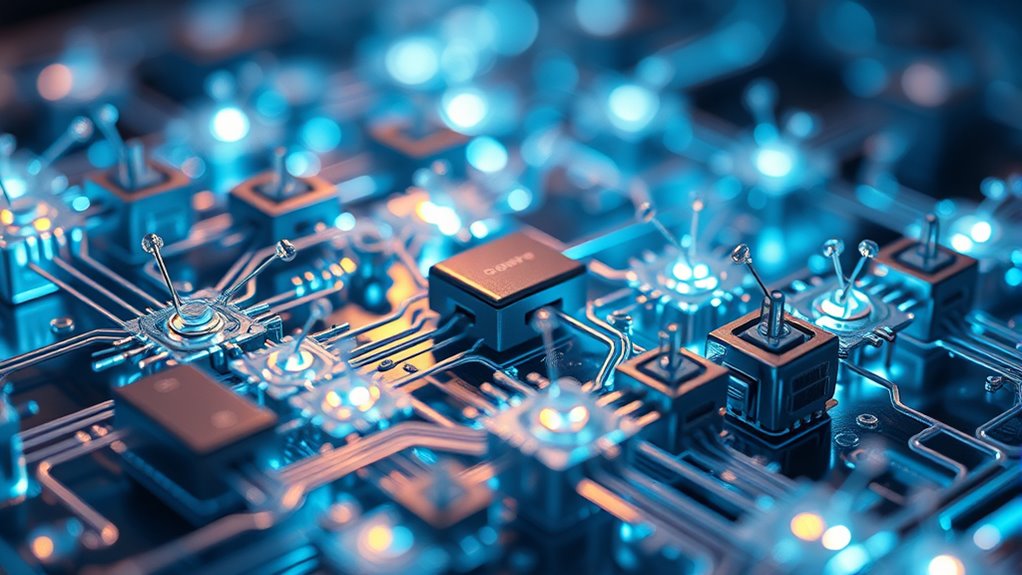
The rapid development of nanomachines integrated with artificial intelligence promises to reshape multiple sectors, from medicine to manufacturing. You can expect emerging trends that push boundaries and create new possibilities.
- Autonomous Nanosystems: Fully self-guided nanomachines will operate independently, performing complex tasks with minimal human intervention.
- Personalized Medicine: AI-driven nanodevices will deliver tailored treatments at the cellular level, improving outcomes and reducing side effects.
- Self-Repairing Nanostructures: Future nanomachines will possess self-healing capabilities, enhancing durability and lifespan of nanosystems.
- Cross-Disciplinary Integration: Combining nanotechnology, AI, and biotech will foster innovative solutions for environmental, energy, and health challenges.
These trends signal a future where nanoscale AI systems become indispensable across industries, unleashing unprecedented potential.
Case Studies Demonstrating Nanoscale AI Successes

Numerous real-world applications showcase how nanoscale AI has achieved remarkable success across various fields. For example, in medicine, nanoscale AI-powered robots target cancer cells with pinpoint accuracy, reducing side effects and improving treatment outcomes. In environmental monitoring, nanosensors equipped with AI analyze pollutants at the molecular level, enabling rapid detection and response to hazards. Agricultural advancements include nanoscale AI systems that optimize crop health by monitoring soil conditions and plant health in real time. Additionally, in electronics, nanoscale AI components enhance device performance and energy efficiency. These case studies demonstrate that integrating AI into nanomachines not only enhances precision and speed but also opens new possibilities for innovation and problem-solving at the smallest scales.
Impact on Industries and Daily Life
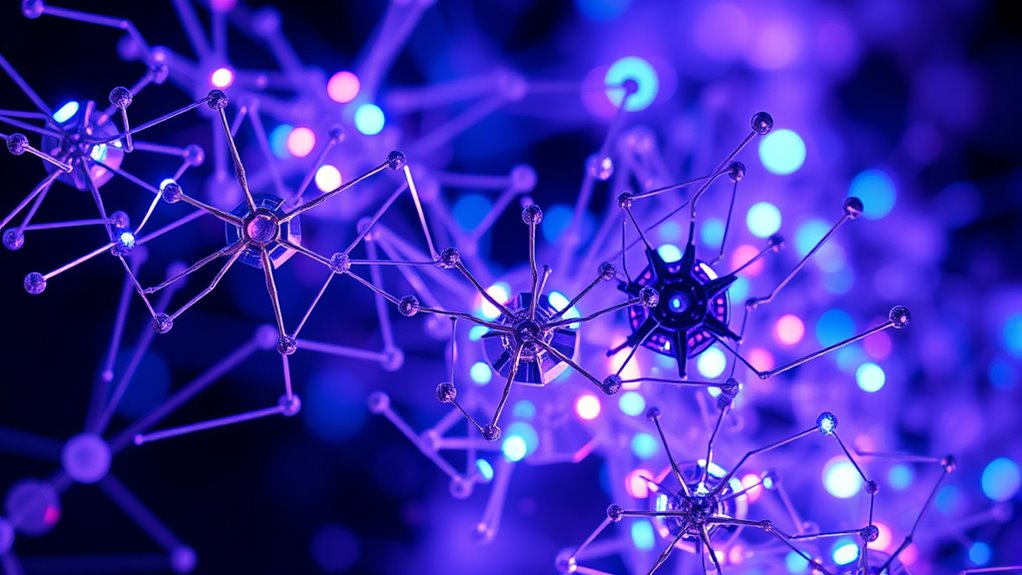
Nanoscale AI innovations are beginning to reshape industries and influence daily life in profound ways. You might notice smarter healthcare with targeted drug delivery, reducing side effects and improving outcomes. In manufacturing, nanomachines enable precise assembly, increasing efficiency and reducing waste. Consumer products, like clothing and gadgets, become more adaptive and responsive thanks to embedded nanosensors. Ultimately, environmental monitoring improves as nanoscale AI detects pollutants at molecular levels, enabling quicker responses. Here’s what’s happening:
Nanoscale AI is revolutionizing healthcare, manufacturing, consumer tech, and environmental monitoring for a smarter, safer future.
- Healthcare advances with personalized treatments.
- Manufacturing becomes more efficient and sustainable.
- Consumer devices gain smarter, real-time capabilities.
- Environmental protection becomes more proactive.
These innovations are transforming how you live and work, making everyday experiences more convenient, safe, and tailored to your needs.
Frequently Asked Questions
How Do Nanoscale Machines Communicate With Each Other?
You can think of nanoscale machines communicating through chemical signals, like molecules or ions, that they release and detect. They send messages by changing concentrations or releasing specific substances, which other machines sense and respond to. Sometimes, they also use physical interactions, such as vibrations or electromagnetic signals, to coordinate their actions. This allows them to work together efficiently, almost like a tiny, coordinated team at the nanoscale.
What Are the Energy Sources for Nanomachines in Biological Systems?
Biological nanomachines primarily harness hydrogen, ATP, and chemical reactions as their energy sources. You’ll find that ATP acts as a tiny power pack, fueling movement and functions. Hydrogen ions generate energy through gradients, while chemical reactions release essential power. By tapping into these natural sources, nanomachines can seamlessly serve biological purposes, effectively functioning within complex cellular systems. This efficient energy exchange keeps biological nanomachines active and adaptable in living organisms.
Can Nanoscale AI Systems Repair Themselves Automatically?
Yes, nanoscale AI systems can potentially repair themselves automatically. You’d see these systems designed with self-healing capabilities, enabling them to detect damage and activate repair processes without human intervention. This auto-repair function relies on embedded algorithms and materials that respond to stress or faults, ensuring continuous operation. As technology advances, these mechanisms will become more sophisticated, making nanoscale AI systems more resilient and reliable in various applications.
What Are the Regulatory Hurdles for Deploying Nanomachines Publicly?
You’ll face significant regulatory hurdles when deploying nanomachines publicly. Authorities require thorough safety assessments, environmental impact studies, and strict standards to prevent misuse or unintended consequences. You must navigate complex approval processes, address ethical concerns, and guarantee transparency. Staying compliant involves working closely with regulators, demonstrating safety, and establishing clear guidelines for responsible use. Overcoming these hurdles ensures public trust and safe integration of nanomachines into everyday life.
How Do Nanoscale Devices Handle Data Security and Privacy Concerns?
Imagine tiny guardians silently watching over your data. Nanoscale devices use advanced encryption and secure data pathways to protect your information, preventing unauthorized access. They incorporate robust security protocols, much like high-tech lockboxes, and continuously monitor for threats. By leveraging decentralized networks, they reduce vulnerabilities, ensuring your privacy remains intact. These microscopic sentinels work tirelessly, turning your data into an unbreakable fortress at the tiniest scales.
Conclusion
As you explore the world of nanoscale AI, it’s fascinating how these tiny machines could revolutionize industries and daily life. Coincidentally, breakthroughs in materials and ethical debates are shaping their future, making it clear that your role in this evolving landscape is more important than ever. As these smart systems grow smarter, you’ll find yourself at the forefront of a technological revolution—where the smallest innovations can have the biggest impact.
